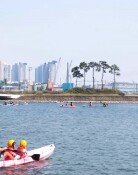Seoul should not consider Kim Jong Un as dialogue partner
Seoul should not consider Kim Jong Un as dialogue partner
Posted July. 31, 2017 07:38,
Updated July. 31, 2017 08:16
North Korea conducted the second test launch of the Hwasong-14 type, an ICBM-class missile, from a site at the village of Mupyong-ri in Jakang Province in a surprise move at 11:41 p.m. on Friday. The North claimed the missile, which was fired at a high angle, reached the maximum altitude of 3,724.9 kilometers, flew 998 kilometers during 47 minutes and 12 seconds before falling into targeted international waters. The flying altitude of the missile increased by more than 900 kilometers from the first round launch on July 4, and if it had been fired at a normal angle, the maximum range of the missile would have exceeded an estimated distance of more than 10,000 kilometers. “We have clearly demonstrated our capacity to launch an ICBM rocket as a surprise at any random region, location and place and at any time, and that the entire U.S. mainland is within our target range,” North Korean leader Kim Jong Un braggingly said.
In an emergency full-member meeting of the National Security Council that was assembled at 1 a.m. on Saturday, President Moon Jae-in said, “The latest launch of the missile could entail fundamental change to security structure in Northeast Asia." He also called for stern responses including start of consultations with Washington to amend the South Korea-U.S. missile guidelines to increase the weight of warheads and maximum range of South Korea’s missiles. The leaderships of the South Korean and U.S. militaries discussed military options for the first time on the day, while the militaries of the two allies started a joint missile firing drill in South Korea’s east coast regions. Two B-1B Lancer long-range bombers dubbed the "swan of death" flew into the Korean Peninsula from the U.S. airbase in Guam in a show of force on Sunday. The Korean Peninsula is embracing a grave situation wherein the rumor of August crisis is replacing the rumor of April crisis.
On reentry of the nuclear warhead into the atmosphere, the North claimed, “We validated that the missile maintained structural stability in the frontal segment even at ultrahigh temperatures of thousands of degrees Celsius, and that the detonation control device for the warhead operated normally.” It has yet to be verified whether the North has secured technology for reentry of the warhead into the atmosphere, the key element of an ICBM, but Pyongyang threats, “We will launch a preemptive nuclear strike into the heart of the American imperialists," which can no longer be disregarded merely as bragging and lies. In the worst case scenario, the deployment of the U.S. military’s backup forces in the event of an armed conflict on the Korean Peninsula could face a serious obstacle. If the U.S.’ expanded deterrence strategy that is designed to defend South Korea as if the U.S. mainland becomes more difficult to execute, the South Korea-U.S. alliance itself could be in jeopardy. Against this backdrop, the South Korean presidential office said, “If the missile is proven to be an ICBM, it has reached the threshold of redline.”
In order for South Korea to overcome a crisis in which its very survival is at stake, the Moon Jae-in administration should dump its naïve belief that it can bring about the North’s give-up of nuclear weapons through dialogue and compensation. President Moon’s Berlin declaration that calls for freezing of nuclear weapons and restriction of military spending before signing of a Korean Peninsula peace treaty under the assumption of the North’s halt of provocations is an unrealistic policy goal in the current phase of situation. Unless sanctions and pressure against Pyongyang are strong enough to be taken even by assuming the possibility for the Kim Jong Un regime’s collapse, there is no chance for Kim to change his idea. South Korea should hold serious consultations with the U.S. to either significantly increase the weight cap of warheads for its missiles, which is currently set at 500 kilograms, or outright nullify it, and to come up with extraordinary countermeasures including redeployment of tactical nuclear weapons in the South. It is a measure that no one wants, but Seoul should also be ready for a military solution considering the grave security situation it is currently facing. The reality is that there is no solution that can make both President Moon and North Korean leader Kim Jong Un simile together.







